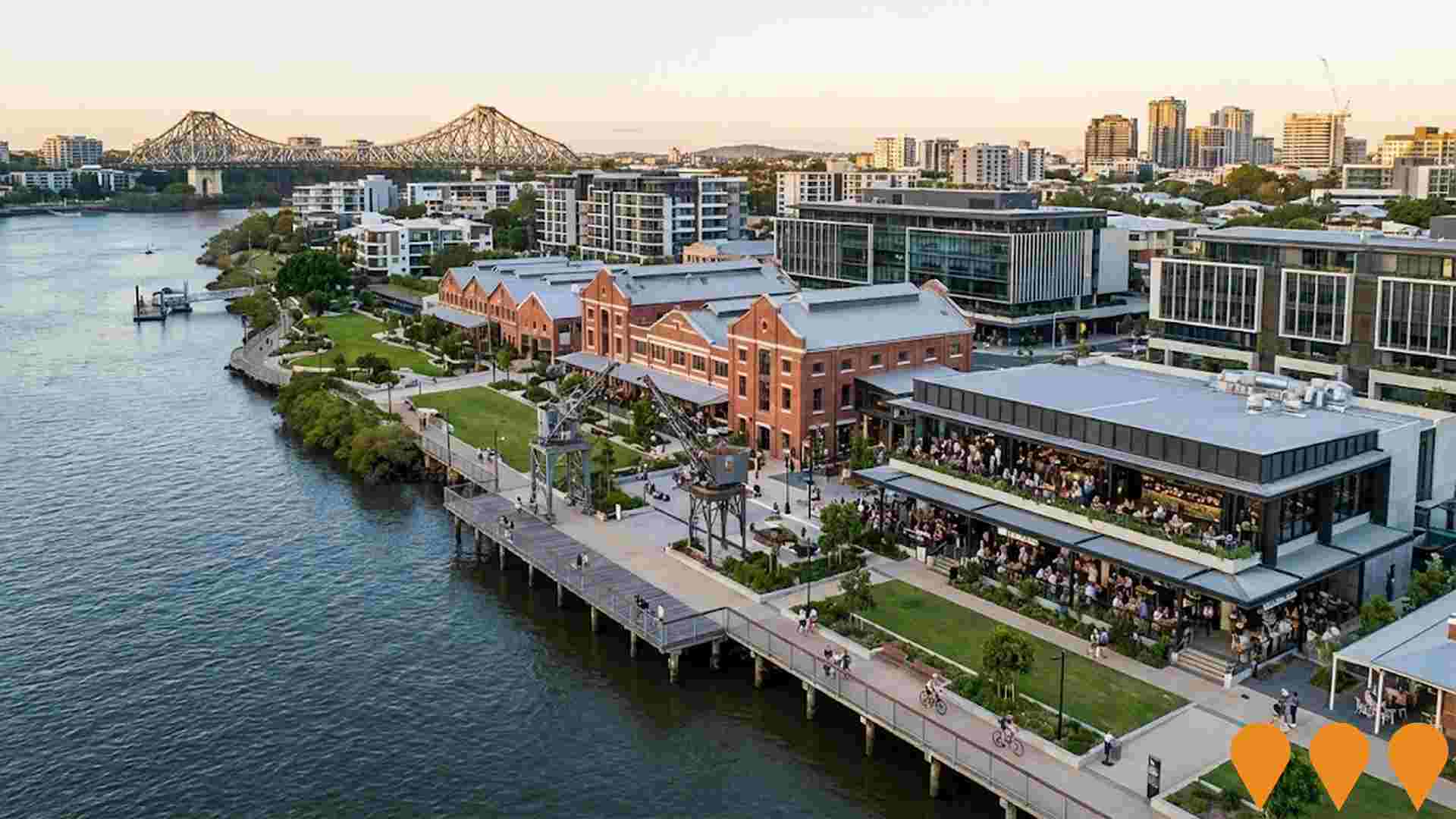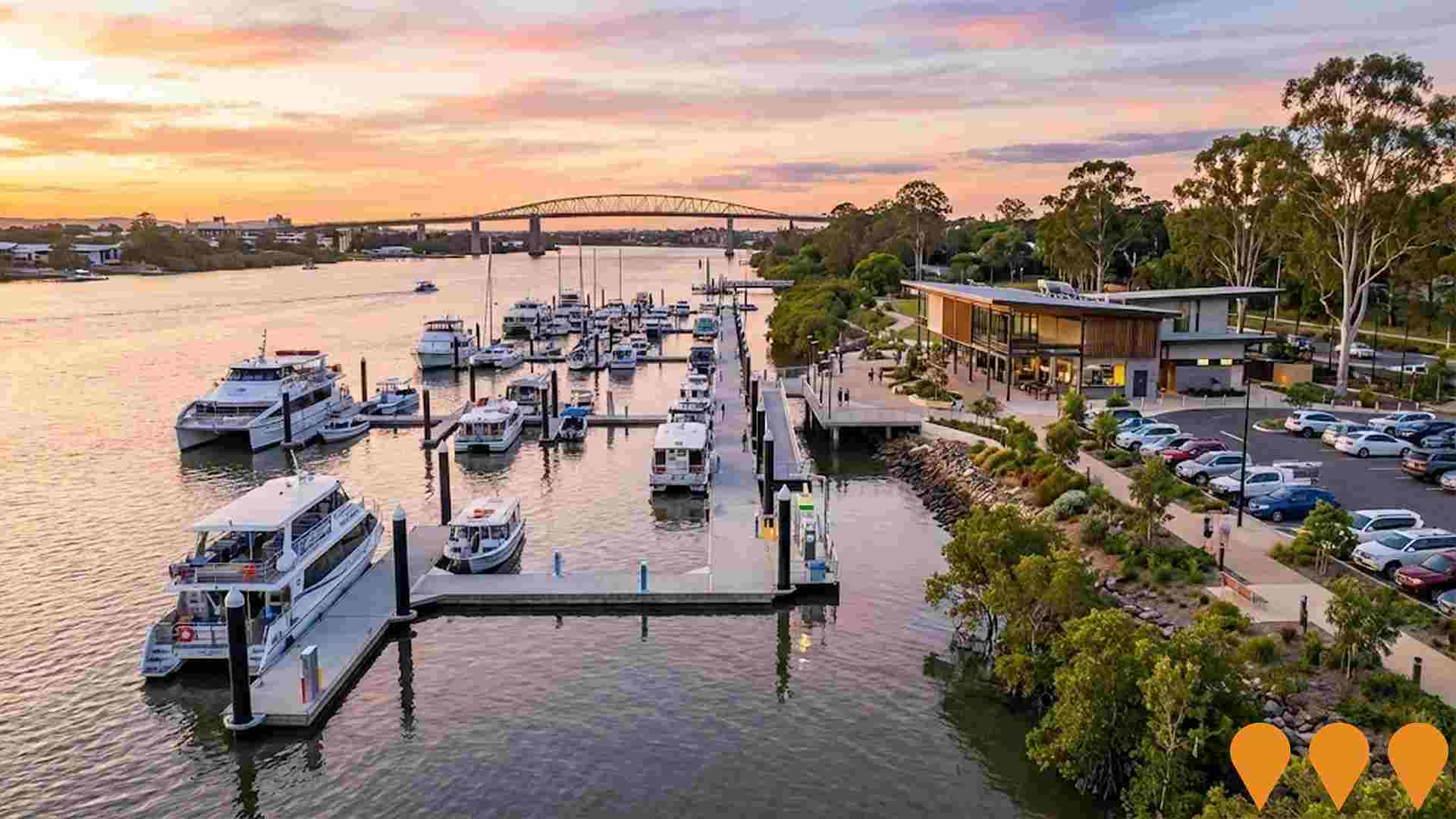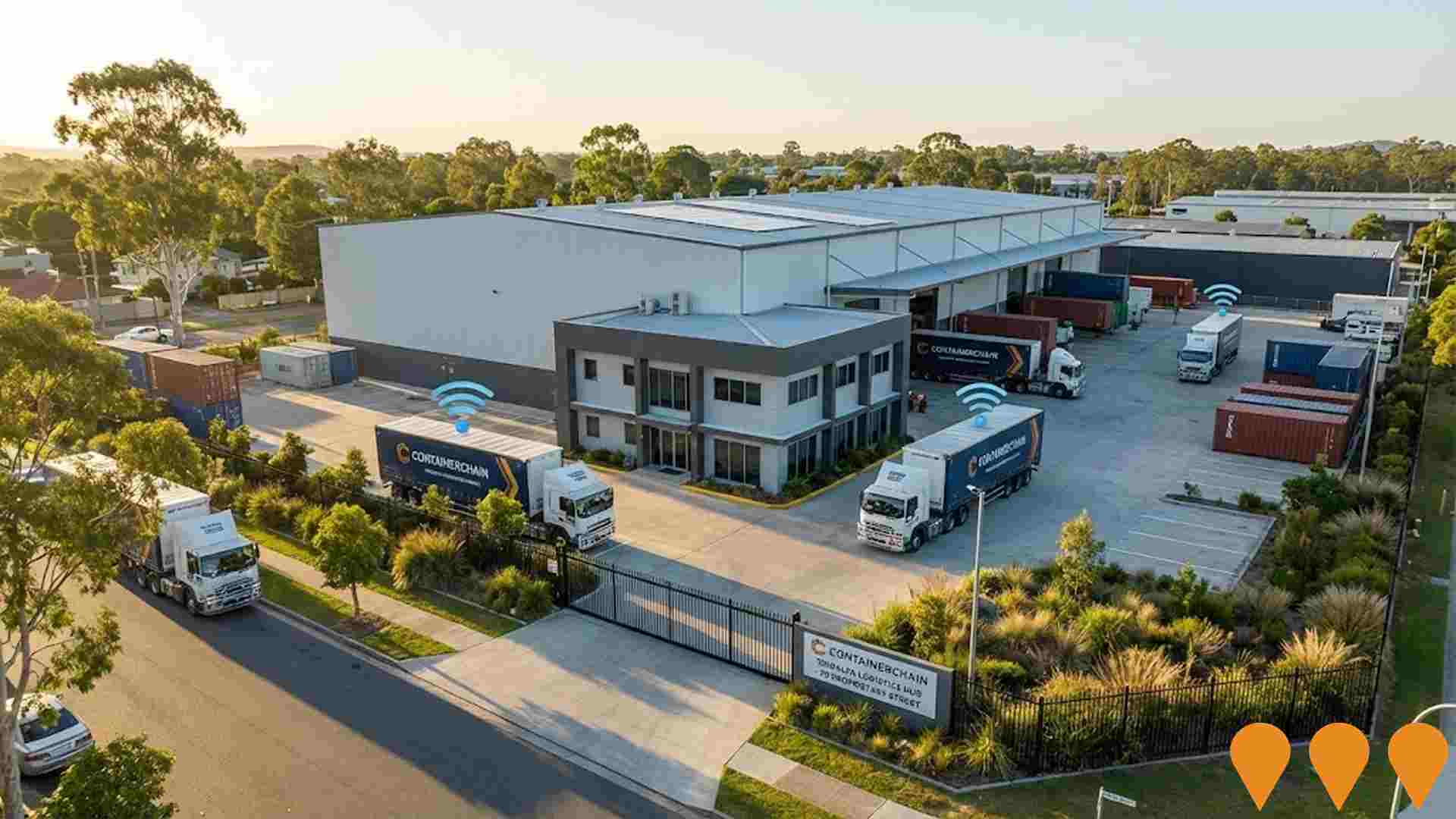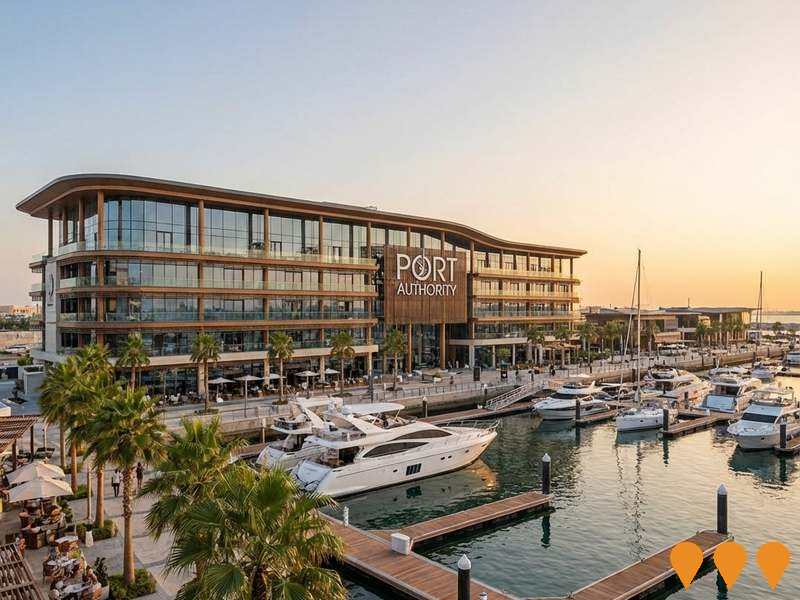Chart Color Schemes
est. as @ -- *
ABS ERP | -- people | --
2021 Census | -- people
Sales Activity
Curious about local property values? Filter the chart to assess the volume and appreciation (including resales) trends and regional comparisons, or scroll to the map below view this information at an individual property level.
Find a Recent Sale
Sales Detail
Population
Murarrie lies within the top quartile of areas nationally for population growth performance according to AreaSearch analysis of recent, and medium to long-term trends
Murarrie's population was around 5,164 as of Aug 2025. This showed an increase of 389 people from the 2021 Census figure of 4,775, reflecting a growth rate of 8.1%. The change was inferred from ABS estimates and validated new addresses since the Census date. The population density was 611 persons per square kilometer. Murarrie's growth exceeded both its SA3 area (6.4%) and SA4 region, making it a growth leader. Natural growth contributed approximately 56.8% of overall gains recently, with other migration factors also positive.
AreaSearch uses ABS/Geoscience Australia projections for each SA2 area released in 2024 with a base year of 2022. For areas not covered and years post-2032, Queensland State Government's SA2 area projections from 2023 based on 2021 data are adopted, applying proportional growth weightings for age cohorts. Future trends forecast significant population increase in the top quartile of national statistical areas, with Murarrie expected to expand by 1,366 persons to 2041, a gain of 26.4% over 17 years.
Frequently Asked Questions - Population
Development
AreaSearch assessment of residential development activity positions Murarrie among the top 25% of areas assessed nationwide
Murarrie averaged approximately 26 new dwelling approvals annually between FY-21 and FY-25, with a total of 133 homes approved during this period. In FY-26, one dwelling has been approved so far. On average, 4.3 new residents arrived per dwelling constructed over the past five financial years.
This indicates significant demand exceeding supply, which typically leads to price growth and increased buyer competition. The average construction cost value of new properties was $427,000, aligning with regional trends. In FY-26, commercial approvals totalled $20.8 million, suggesting balanced commercial development activity in Murarrie compared to the Greater Brisbane region. Over the past five years, Murarrie had 22.0% more development per person than the regional average, offering good buyer choice while supporting existing property values. New building activity consisted of 17.0% detached dwellings and 83.0% attached dwellings, reflecting a shift towards compact living to provide affordable entry pathways for downsizers, investors, and first-time purchasers.
This marks a significant change from the current housing mix, which is predominantly houses (73.0%). With around 140 people per dwelling approval, Murarrie exhibits characteristics of a growth area. Population forecasts project an increase of 1,366 residents by 2041. At current development rates, housing supply may struggle to keep pace with population growth, potentially intensifying buyer competition and supporting price increases.
Frequently Asked Questions - Development
Infrastructure
Murarrie has emerging levels of nearby infrastructure activity, ranking in the 34thth percentile nationally
A total of 25 infrastructure projects have been identified by AreaSearch as potentially impacting a specific area. Among these, several key projects are part of the Rivermakers Masterplan. The following list details some of the most relevant projects from this plan.
Professional plan users can use the search below to filter and access additional projects.
INFRASTRUCTURE SEARCH
 Denotes AI-based impression for illustrative purposes only, not to be taken as definitive under any circumstances. Please follow links and conduct other investigations from the project's source for actual imagery. Developers and project owners wishing us to use original imagery please Contact Us and we will do so.
Denotes AI-based impression for illustrative purposes only, not to be taken as definitive under any circumstances. Please follow links and conduct other investigations from the project's source for actual imagery. Developers and project owners wishing us to use original imagery please Contact Us and we will do so.
Frequently Asked Questions - Infrastructure
East Village Cannon Hill
Large-scale $1 billion+ mixed-use urban renewal precinct on the former CSIRO site in Cannon Hill. Features residential apartments (over 600 delivered/planned), commercial office space, retail, dining, cinema, hotel, and significant public realm. Developed by Anthony John Group in stages, with construction active across multiple buildings.

Rivermakers Masterplan
A 30-hectare riverside mixed-use masterplan comprising three distinct precincts: The Depot (mixed industrial and retail), Mixed Business and Industry precinct, and Heritage Quarter (food and beverage destination in restored heritage buildings). The project transforms a former industrial site into a vibrant destination combining artisan manufacturing, commercial spaces, dining, and entertainment. The Hills of Rivermakers dining and entertainment precinct opened December 2024, featuring restored heritage buildings from the 1910 Commonwealth Acetate of Lime Factory. The masterplan includes 250 meters of riverfront recreational space and promotes co-location of industrial and commercial activities without residential components.

Rivermakers Masterplan
A 30-hectare riverside mixed-use masterplan comprising three distinct precincts: The Depot (mixed industrial and retail), Mixed Business and Industry precinct, and Heritage Quarter (food and beverage destination in restored heritage buildings). The project transforms a former industrial site into a vibrant destination combining artisan manufacturing, commercial spaces, dining, and entertainment. The Hills of Rivermakers dining and entertainment precinct opened December 2024, featuring restored heritage buildings from the 1910 Commonwealth Acetate of Lime Factory. The masterplan includes 250 meters of riverfront recreational space and promotes co-location of industrial and commercial activities without residential components.

Rivermakers Masterplan
A 30-hectare riverside mixed-use masterplan comprising three distinct precincts: The Depot (mixed industrial and retail), Mixed Business and Industry precinct, and Heritage Quarter (food and beverage destination in restored heritage buildings). The project transforms a former industrial site into a vibrant destination combining artisan manufacturing, commercial spaces, dining, and entertainment. The Hills of Rivermakers dining and entertainment precinct opened December 2024, featuring restored heritage buildings from the 1910 Commonwealth Acetate of Lime Factory. The masterplan includes 250 meters of riverfront recreational space and promotes co-location of industrial and commercial activities without residential components.

Rivermakers Masterplan
A 30-hectare riverside mixed-use masterplan comprising three distinct precincts: The Depot (mixed industrial and retail), Mixed Business and Industry precinct, and Heritage Quarter (food and beverage destination in restored heritage buildings). The project transforms a former industrial site into a vibrant destination combining artisan manufacturing, commercial spaces, dining, and entertainment. The Hills of Rivermakers dining and entertainment precinct opened December 2024, featuring restored heritage buildings from the 1910 Commonwealth Acetate of Lime Factory. The masterplan includes 250 meters of riverfront recreational space and promotes co-location of industrial and commercial activities without residential components.

Rivermakers Masterplan
A 30-hectare riverside mixed-use masterplan comprising three distinct precincts: The Depot (mixed industrial and retail), Mixed Business and Industry precinct, and Heritage Quarter (food and beverage destination in restored heritage buildings). The project transforms a former industrial site into a vibrant destination combining artisan manufacturing, commercial spaces, dining, and entertainment. The Hills of Rivermakers dining and entertainment precinct opened December 2024, featuring restored heritage buildings from the 1910 Commonwealth Acetate of Lime Factory. The masterplan includes 250 meters of riverfront recreational space and promotes co-location of industrial and commercial activities without residential components.

Colmslie Wharves
A purpose-built commercial marina providing 51 berths for vessels up to 35 metres to support Brisbane's marine tourism industry. The project addresses a critical shortage of commercial berthing following closures at Dockside Marina and Eagle Street Pier. Expected to inject over $100 million annually into the local economy, attract 109,625 additional visitors per year, and create 337 ongoing jobs across tourism, hospitality, and marine services. Backed by a $4 million Queensland Government grant from the Growing Tourism Infrastructure Fund. The marina will include on-water fuelling, wastewater pump-out facilities, car parking, and staff amenities. Construction expected to commence immediately following approval with first vessels arriving in 2026.

Colmslie Wharves
A purpose-built commercial marina providing 51 berths for vessels up to 35 metres to support Brisbane's marine tourism industry. The project addresses a critical shortage of commercial berthing following closures at Dockside Marina and Eagle Street Pier. Expected to inject over $100 million annually into the local economy, attract 109,625 additional visitors per year, and create 337 ongoing jobs across tourism, hospitality, and marine services. Backed by a $4 million Queensland Government grant from the Growing Tourism Infrastructure Fund. The marina will include on-water fuelling, wastewater pump-out facilities, car parking, and staff amenities. Construction expected to commence immediately following approval with first vessels arriving in 2026.

Employment
The labour market strength in Murarrie positions it well ahead of most Australian regions
Murarrie has a highly educated workforce with strong professional services representation. Its unemployment rate was 2.6% as of June 2025, below Greater Brisbane's 4.1%.
Employment growth over the past year was estimated at 4.6%. By June 2025, 3,489 residents were employed, with an unemployment rate of 1.5% lower than Greater Brisbane's. Workforce participation in Murarrie was 75.1%, significantly higher than Greater Brisbane's 64.5%. Leading employment industries among residents included health care & social assistance, professional & technical services, and construction.
The area showed particular strength in professional & technical services, with an employment share of 1.3 times the regional level. However, health care & social assistance had a limited presence at 13.9%, compared to the regional average of 16.1%. As of the Census, there were 3.0 workers per resident, indicating that Murarrie functions as an employment hub hosting more jobs than residents and attracting workers from surrounding areas. Between June 2024 and June 2025, employment in Murarrie increased by 4.6%, while the labour force grew by 4.5%, leading to a decrease in unemployment rate of 0.2 percentage points. In comparison, Greater Brisbane saw employment rise by 4.4%, with a labour force growth of 4.0% and a reduction in unemployment of 0.4 percentage points. Jobs and Skills Australia's national employment forecasts from May 2025 project overall employment growth of 6.6% over five years and 13.7% over ten years. Applying these projections to Murarrie's employment mix suggests potential local growth of approximately 6.7% over five years and 13.7% over ten years, though this is a simple extrapolation for illustrative purposes and does not account for localised population projections.
Frequently Asked Questions - Employment
Income
The economic profile demonstrates exceptional strength, placing the area among the top 10% nationally based on comprehensive AreaSearch income analysis
Murarrie's median income among taxpayers was $65,569 according to ATO data aggregated by AreaSearch for financial year 2022. The average income stood at $81,239 in the same period. These figures compared with Greater Brisbane's median and average incomes of $55,645 and $70,520 respectively. Based on a Wage Price Index growth of 13.99% since financial year 2022, estimates for September 2025 would be approximately $74,742 (median) and $92,604 (average). Census data shows household, family, and personal incomes in Murarrie rank between the 86th and 88th percentiles nationally. Income analysis reveals that 35.5% of locals (1,833 people) fall into the $1,500 - 2,999 weekly income category. Higher earners make up a substantial presence with 37.0% exceeding $3,000 weekly. High housing costs consume 15.8% of income, but strong earnings place disposable income at the 87th percentile nationally. The area's SEIFA income ranking places it in the 8th decile.
Frequently Asked Questions - Income
Housing
Murarrie is characterized by a predominantly suburban housing profile, with a higher proportion of rental properties than the broader region
In Murarrie, as per the latest Census, 72.7% of dwellings were houses, with the remaining 27.4% being semi-detached homes, apartments, or other types. In comparison, Brisbane metropolitan area had 78.0% houses and 22.0% other dwellings. Home ownership in Murarrie stood at 20.6%, with mortgaged properties at 43.7% and rented ones at 35.7%. The median monthly mortgage repayment was $2,167, higher than Brisbane's average of $2,100. The median weekly rent in Murarrie was $450, compared to Brisbane's $420. Nationally, Murarrie's mortgage repayments were significantly higher at $2,167 vs Australia's average of $1,863, and rents were substantially higher at $450 vs the national figure of $375.
Frequently Asked Questions - Housing
Household Composition
Murarrie features high concentrations of group households, with a fairly typical median household size
Family households account for 74.3% of all households, including 33.0% couples with children, 28.0% couples without children, and 11.5% single parent families. Non-family households make up the remaining 25.7%, with lone person households at 19.4% and group households comprising 6.0%. The median household size is 2.6 people, matching the Greater Brisbane average.
Frequently Asked Questions - Households
Local Schools & Education
Murarrie shows below-average educational performance compared to national benchmarks, though pockets of achievement exist
Murarrie's educational attainment is notably higher than broader benchmarks. Among residents aged 15 and above, 35.1% hold university qualifications, compared to 23.7% in the SA4 region and 25.7% in Queensland. Bachelor degrees are the most common at 24.3%, followed by postgraduate qualifications (7.3%) and graduate diplomas (3.5%). Vocational credentials are also prevalent, with 34.5% of residents aged 15 and above holding such qualifications - advanced diplomas at 12.6% and certificates at 21.9%.
Educational participation is high, with 29.3% of residents currently enrolled in formal education. This includes 9.4% in primary education, 7.4% in secondary education, and 6.5% pursuing tertiary education. Murarrie State School serves the local area, with an enrollment of 57 students as of a recent report. The school's ICSEA score is 950, indicating typical Australian school conditions with balanced educational opportunities. It focuses exclusively on primary education, with secondary options available in nearby areas. Local school capacity is limited, with 1.1 places per 100 residents compared to the regional average of 13.6, leading many families to travel for schooling.
Frequently Asked Questions - Education
Schools Detail
Nearby Services & Amenities
Transport
Transport servicing is good compared to other areas nationally based on assessment of service frequency, route connectivity and accessibility
Murarrie has 16 operational public transport stops. These include a mix of train and bus services. There are 28 different routes serving these stops, providing a total of 2,572 weekly passenger trips.
Transport accessibility in the area is rated good, with residents on average located 257 meters from their nearest transport stop. The service frequency averages 367 trips per day across all routes, which equates to approximately 160 weekly trips per individual stop.
Frequently Asked Questions - Transport
Transport Stops Detail
Health
Murarrie's residents are extremely healthy with prevalence of common health conditions low among the general population though higher than the nation's average across older, at risk cohorts
Analysis of health metrics indicates strong performance throughout Murarrie. Prevalence of common health conditions is low among the general population but higher than the national average among older, at-risk cohorts. The rate of private health cover is exceptionally high at approximately 61% of the total population (3,139 people), compared to 58.6% across Greater Brisbane and 55.3% nationally.
The most common medical conditions in the area are mental health issues and asthma, affecting 9.1 and 8.0% of residents respectively, while 72.2% of residents report being completely clear of medical ailments compared to 69.4% across Greater Brisbane. The area has 9.4% of residents aged 65 and over (484 people), which is lower than the 16.7% in Greater Brisbane.
Frequently Asked Questions - Health
Cultural Diversity
Murarrie was found to be more culturally diverse than the vast majority of local markets in Australia, upon assessment of a range of language and cultural background related metrics
Murarrie's population was found to be more culturally diverse than most local areas, with 15.9% speaking a language other than English at home and 28.1% born overseas. Christianity was the predominant religion in Murarrie, accounting for 49.0% of its population. Notably, Judaism was overrepresented compared to Greater Brisbane, comprising 0.2% versus 0.1%.
The top three ancestry groups were English (26.0%), Australian (23.0%), and Irish (9.7%). Some ethnic groups showed notable differences: New Zealanders made up 1.6% of Murarrie's population compared to 1.3% regionally, Maori comprised 0.9% versus 1.4%, and South Africans were at 0.7% compared to 0.8%.
Frequently Asked Questions - Diversity
Age
Murarrie's population is younger than the national pattern
Murarrie's median age is 35 years, nearly matching Greater Brisbane's average of 36 and somewhat younger than Australia's 38 years. Compared to Greater Brisbane, Murarrie has a higher percentage of residents aged 35-44 (18.2%) but fewer residents aged 65-74 (5.5%). Between the 2021 Census and the present day, the population aged 15-24 grew from 12.1% to 13.2%, while the 55-64 cohort increased from 9.4% to 10.5%. Conversely, the 5-14 age group declined from 12.3% to 10.7%, and the 25-34 group dropped from 18.6% to 17.0%. Population forecasts for 2041 indicate significant demographic changes in Murarrie. The 45-54 cohort is projected to grow by 47%, adding 369 residents to reach a total of 1,150. In contrast, the 0-4 age group shows minimal growth of just 4% (12 people).



